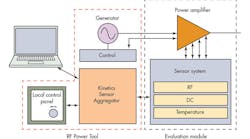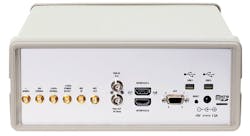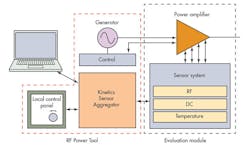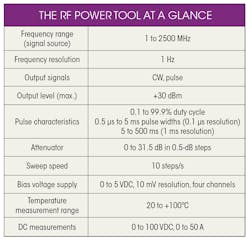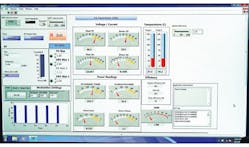This file type includes high resolution graphics and schematics when applicable.
Optimizing an RF/microwave amplifier demands a fair bit of knowledge, and can require a healthy rack of test equipment. Fortunately, Freescale Semiconductor has taken a major step toward helping engineers in need of optimizing a high-frequency amplifier with its RF Power Tool. In spite of measuring only 4 × 10 × 13 in. and weighing a mere 6 lbs., this offering is capable of making all the key amplifier measurements, including gain, efficiency, bandwidth, and bias requirements.
The RF Power Tool plugs into a Freescale evaluation board, and requires only a few external components (principally a DC power supply and dummy load), effectively forming a “bench in a box.” It allows designers to completely evaluate and optimize the performance of an amplifier circuit on a Freescale evaluation board.
Freescale’s RF Power Tool (Fig. 1) includes the instrument; a power supply (with adapters for use in the United States, Australia, Europe, and the United Kingdom); a flexible microwave cable with SMA connectors; a pair of cables that connect to the evaluation board, a Universal Serial Bus (USB) cable for connecting the instrument to a personal computer (PC); and Microsoft Windows software that runs on any version of the operating system (OS) from Windows XP forward. To work with the RF Power Tool, a user selects an evaluation board suitable for an amplifier under test, a high-power DC supply, a dummy load (termination), heat sink, and a coaxial cable to connect the amplifier to the dummy load (Fig. 2).
Evaluation boards are available for power levels from 50 W to 125 kW for various applications. The boards are equipped with the required sensors and other connectors that mate with the RF Power Tool. For users wishing to design their own test routines, the instrument supports SCPI-compliant command sets (also available from Freescale), and is compatible with LabVIEW test software from National Instruments.
The RF Power Tool includes a full range of RF and DC sources and sensors as needed for amplifier testing. The core capability is a continuous-wave (CW)/pulse signal generator with 1-Hz tuning resolution from1 MHz to 2.5 GHz and a digital step attenuator with maximum range of 0 to 31.5 dB in 0.5-dB steps to adjust RF output levels to +30 dBm. The compact test set provides three 150-mW output ports—from 1 to 400 MHz, 300 to 1200 MHz, and at 2.4 GHz—with an additional 2.4-GHz port with 1-W output level. This is needed for such applications as industrial heating, where at least 350-mW drive must be supplied.
The test instrument offer flexible pulsed signal capabilities, generating pulse widths from 0.5 μs to 5 ms in 0.1-μs steps and pulse widths from 5 ms to 1 s in 1-ms steps across a duty-cycle range of 0.1 to 99.9%. It includes internal triggering circuits and an input for external triggering. It also features four watt meters with directional couplers and the capability to measure forward and reflected power levels from 1 mW to 2 kW across its frequency range.
The RF Power Tool also includes multiple voltmeters and ammeters, as well as four bias supplies and an RF driver amplifier. The four-channel bias supply delivers voltages from 0 to 5 VDC with 10-mV resolution, and DC measurement capability ranges from 0 to 100 VDC and 0 to 250 A (see table).
The RF Power Tool is by no means a replacement for a full rack of test gear, and does not offer the performance levels needed for checking low-noise amplifiers (LNAs). Nevertheless, it does provide the capabilities necessary for evaluating and optimizing a wide range of amplifiers (through 2.5 GHz). For example, appliance manufacturers that employ solid-state RF power sources; RF subsystem design companies and their suppliers; and manufacturers of systems that employ RF power for various purposes (including heating, drying, and sealing) may have limited solid-state RF power design experience and RF test equipment. They might even be making a transition from vacuum tubes to solid-state power. and might benefit from having simple measurement capabilities.
Others likely to benefit from this simplified approach include medical equipment manufacturers, distributors, universities, and even hobbyists (such as ham-radio operators). Since the entire optimization process can be accomplished using this single instrument, a PC, a DC power supply, and a dummy load, it can be performed anywhere where AC power is available.
This file type includes high resolution graphics and schematics when applicable.
Evaluation Assessment
This file type includes high resolution graphics and schematics when applicable.
Once the instrument is connected to a PC and the appropriate accessories, the test/evaluation process for an amplifier is quite simple. The Freescale evaluation boards are individually calibrated and work in the manner of power sensors, communicating their configuration, capabilities, and measurement limits to the RF Power Tool. A display on the PC guides an operator (Fig. 3), showing the test configuration and various points in the evaluation board at which changes to values can be made with a single mouse click.
When a change is made to a value, all other values dependent upon it are also updated at a rate between 3 and 10 times/s. Changes in basic values and other parameters can be made from the instrument front panel using a thumbwheel and the instrument’s small thin-film-transistor (TFT) liquid-crystal-display (PCD) backlit screen. Indicators show when an error has occurred or an out-of-limit condition has been reached.
In a basic application, a user would use the tester to validate the performance of an amplifier under test. But the RF Power Tool can also be used to fine-tune the performance of an amplifier, with the test display notifying a user when certain conditions have exceeded the limits of the amplifier’s integrated circuits (ICs) or the amplifier itself. For example, if the system to which the amplifier is connected cannot achieve a VSWR lower than 3.0:1, the RF Power Tool makes it possible to determine whether an acceptable solution can be achieved or whether redesign work is required.
Although the RF Power Tool doesn’t perform continuous sweeps over its range of frequencies, it does allow an operator to specify as many as 64 measurement points at selectable intervals between two frequency points, with measurements made at each one of these points at 100 μs/step. All the time, it is collecting data on current, voltage, RF power level, VSWR, and other parameters. A full complement of pulsed-signal features allows a test routine to be set up that triggers via the instrument’s external input.
The RF Power Tool’s compatibility with LabVIEW software allows it to be readily integrated with larger systems containing such functions as signal generators, power meters, even vector network analyzers (VNAs), and programs and histories of measurements can be established and stored in each system. In addition, data can be exported as .csv files for analysis by means of Microsoft Excel software.
This represents the first iteration of the RF Power Tool, with enhancements and improvements to be expected from Freescale on a regular basis. Since the test system, with accompanying computer and accessories, can be readily transported in a box or two, amplifier evaluations can be performed almost anywhere, even at a customer’s facility. This compact box should certainly have an impact on how many engineers plan their amplifier optimizations going forward.
David Lester, Technical Marketing Manager
Freescale Semiconductor, 2100 E. Elliott Rd., Tempe, AZ 85284; (800) 521-6274
This file type includes high resolution graphics and schematics when applicable.
